|
Monday, January 23, 2012
Progress Notes
Recently, we have had two donations of historical interest having to do with the Spring Garden area in the north part of Miller County. The first one was a set of really old maps contained in a specially designed wooden display box which was used at the Spring Garden School many years ago, probably around the turn of the century or before (photo 01).
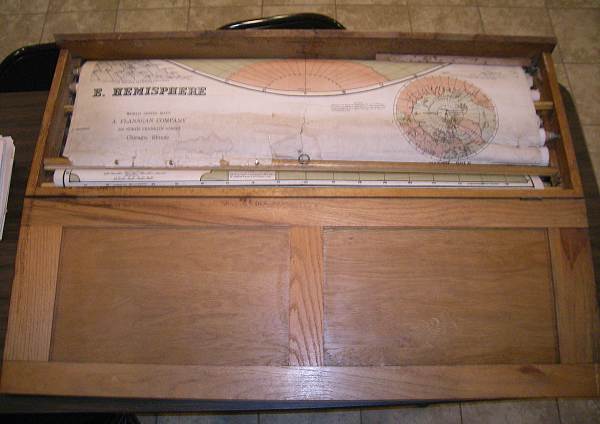
01 Miller County Maps
Board member Gary Carrender (photo 02) had received them from his daughter, Sarah Wallace.
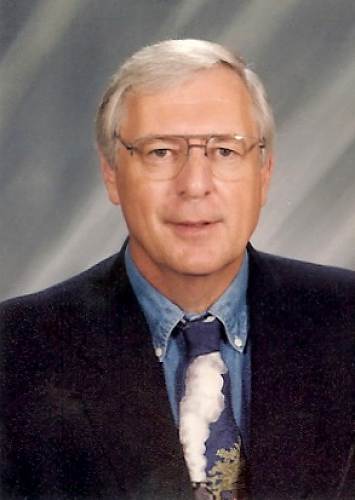
02 Gary Carrender
Sarah and her 4-H club were helping others in the Spring Garden community restore and repair the old one room school house located there (photos 03 and 04).
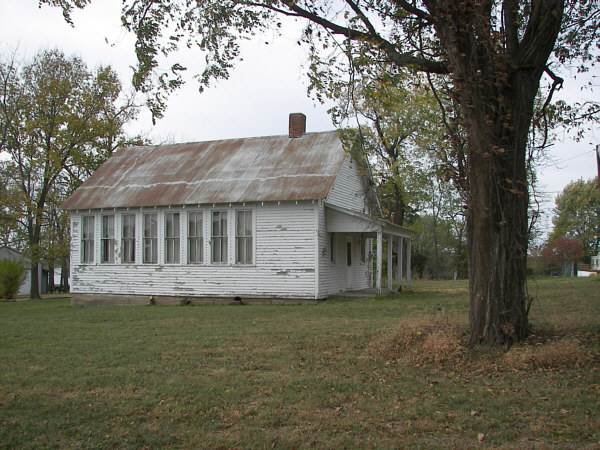
03 Spring Garden School
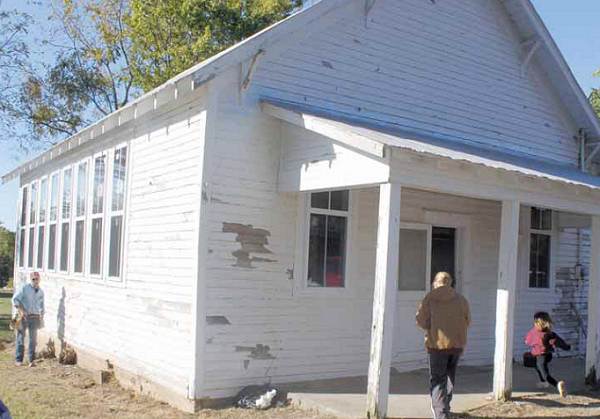
04 Workers at Spring Garden School - Eldon Advertiser
During that effort Heather Looten of Spring Garden discovered the old maps. Heather called our museum and inquired if we would like to receive them for display in our replica of an old one room school at the museum. Of course, we replied enthusiastically in the affirmative. Heather’s only requirement was that the maps be displayed to which, of course, we certainly agreed.
The second donation we have received recently was from Pauline and Ron Tom of Mountain City, Texas. The donation was a framed 1904 diploma which had been issued by the Miller County Institute, the famous educational facility which was established in Spring Garden before the turn of the last century (photo 05).
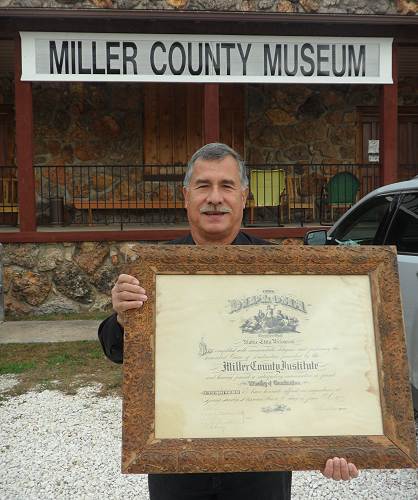
05 Ron Tom with Certificate
The diploma had been issued to a student named Mattie Edna Wilcoxson. The Toms’ had bought the framed diploma at an auction. We do not have any information now regarding Mattie Edna Wilcoxson except for the fact that the Wilcoxsons’ were one of our predominant Miller County families in the past.
The story of the Miller County Institute which was started by William Lumpkin is on our website.
More about the Insitute is found at the Spring Garden website.
And I wrote about the school as well at this previous Progress Notes.
I will copy here the section which refers to the school:
“The first institute of higher learning that brought attention to Spring Garden was the Spring Garden Seminary, a private school for girls only that was established in 1866, using the old Christian Church building in what is now the northwest corner of the cemetery, according to Clyde Lee Jenkins.
In 1868 the community erected a two-story frame schoolhouse in which Prof. William M. Lumpkin taught the first classes and which was incorporated as the Spring Garden Seminary. He was joined by Julia A.H. Colby who came from Springfield to join the faculty, and Edward A. Henry of Mt. Pleasant (photo 06).
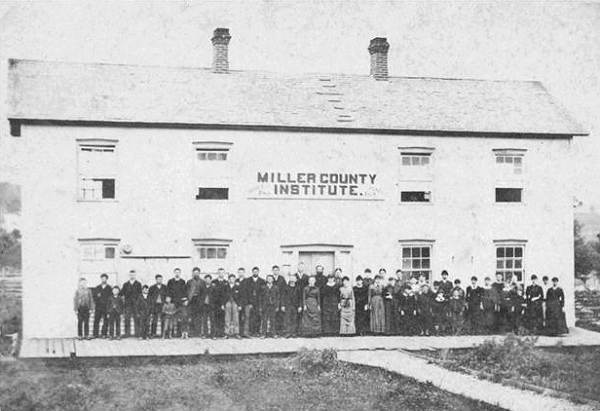
06 Miller County Institute Group Photo
In 1879 Professors H.M. Sutton of Ada, Okla., and H.L. Moles of Clarksburg took charge of the school and changed the name to the Miller County Institute. The Institute, which drew students from a wide area, prospered and the community around it grew (photo 07).
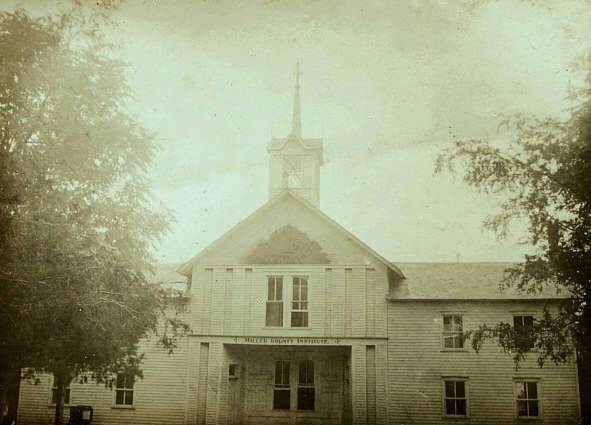
07 Miller County Institute Revised
Here are a couple of advertisements published in the local papers about the school (photos 08 and 09):
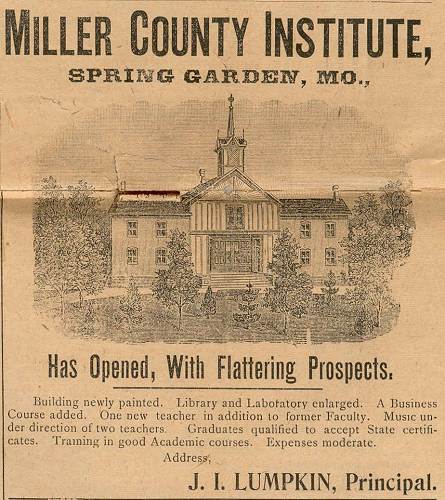
08 Miller County Institute Opening
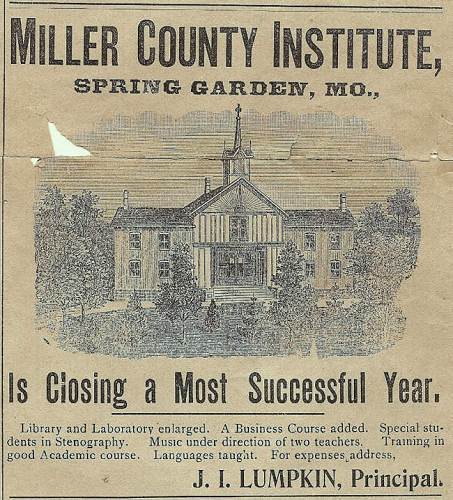
09 Miller County Institute Closing
In our museum we have an original “Certificate of Rank” framed and hanging on the wall where we have a small display featuring the Miller County Institute (photo 10).
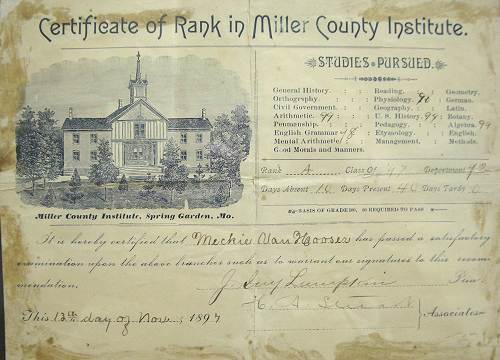
10 Certificate of Rank in Miller County Institute
Here is a photo of the Lumpkin family home (photo 11):

11 Lumpkin Family Home - Spring Garden - John Simpson Lumpkin Far Left
Much of the information about the Spring Garden Institute I obtained from Betsy (Elizabeth) Ann Wogan, who is the great granddaughter of William Simpson Lumpkin, the educator who established the Spring Garden Academy (photos 12 and 13).
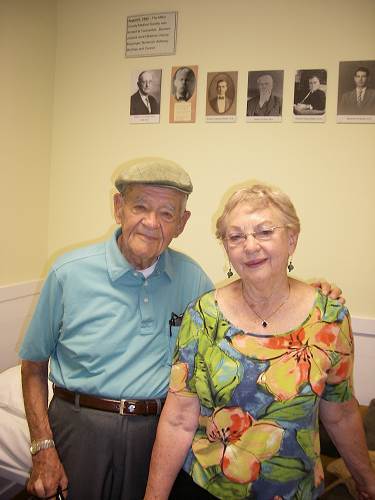
12 Bamber Wright and Betsy Wogan
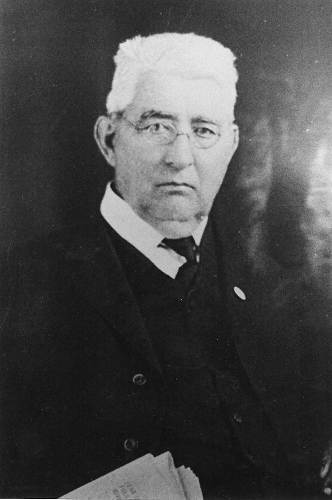
13 William Simpson Lumpkin - 1832-1925
Betsy, who lives in Texas, came to visit me at the museum in the fall of 2010 bringing many photos of family members not only from the Lumpkin side but also from the Kouns side as well. She is a granddaughter of Douglas Horton Kouns M.D., who practiced medicine in Tuscumbia for more than fifty years beginning in the late 1800’s (photo 14).
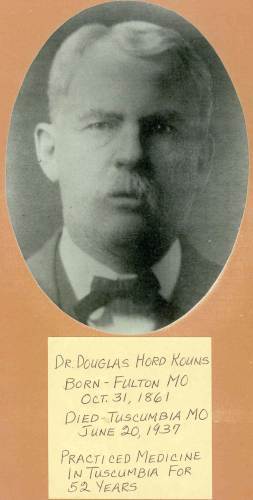
14 Dr. Douglas Hord Kouns
For a more complete history of the Spring Garden Institute, the Lumpkin family, and the Kouns family I refer you to the website listed above.
I have the habit of reading old obituaries and am lucky to be associated with the Miller County Museum where we have an ongoing obituary file collection program. I also search for obituaries contained in the microfilm archives of old editions of the Autogram and Advertiser located at the Vernon Publishing Company’s office in Eldon. One obituary I found recently that was of interest to me was that of William Z. Burton (known as Uncle Zack”) who was born in 1830 and died in 1926 at the age of 96 (photo 15).

15 Uncle Zack Burton
A search of our website reveals several references to William Z. Burton. He is recorded as living in Osage Township near Capps in the old community known as Ramsey. He was a livestock farmer and also at times served as a Justice of the Peace.
The first reason his obituary was of interest to me is that he was one of the older people to have been buried at the Bear Cemetery (my family’s cemetery) (photo 16); only six other deceased individuals buried at the Bear Cemetery were older than he.

16 Bear Cemetery
The second reason he was of interest was because his wife, Eliza, was the granddaughter of John Wilson, whose story we reviewed a few weeks ago when John Schultz, son of noted historian Gerard Schultz and himself a descendent of John Wilson, visited our museum. John arrived accompanied by his extended family and guided all of us to and through the Wilson Cave, the story of which he knew intimately.
You can read that edition of Progess Notes here.
The relation of Eliza (Elizabeth), wife of Uncle Zack, to John Wilson was described in the above cited website by Clyde Lee Jenkins:
“Of John's and Nellie's children, Alexander was married to Tabitha Pogue, a widow, and mother of daughters Margaret Pogue, who was married to Charles A. Martin, and Martha Ann Pogue, who was married to P.C. Brumley, a son of Daniel.
Alexander and Tabitha were the parents of Elizabeth, born in 1833, who married a Burton; John born Oct. 6, 1836; Ellender who was married to John F. Barr on Nov. 16, 1856; William; Madison Ray, who was married to Huldy Jane Glesom on Nov. 25, 1866; Robert; and Alexander H.”
But the third and most peculiar reason I was interested in Zack Burton’s story has to do with something else I will describe later. First, however, I will present Zack’s obituary:
Thursday, September 16, 1926
Miller County Autogram
Uncle Zack Burton Dies At The Age Of Ninety Six Years
His father Was Soldier in the Black Hawk War
William Z. Burton, familiarly known to Miller County people as “Uncle Zack,” died at the home of his son, J.W. Burton, of Tulsa, Oklahoma, Thursday, September 9, at the advanced age of 96 years and seven months.
Uncle Zack was born in Adair County, Kentucky, January 21, 1830, being the second of three children born to Paris and Mary (Burton) Burton, who were also Kentuckians. The father was a farmer, and also a soldier of the Black Hawk War. His father was a native of Ireland.
Uncle Zack was reared on a farm, and educated in the schools of Kentucky. After reaching his adulthood he wedded Eliza Wilson, and soon after purchased a farm and began freeing it of timber and getting it under cultivation, and here continued to make his home until 1882 when he purchased a 400 acre farm where he resided a number of years. Through his energy and good management he raised a large family of children who became some of our best citizens. His wife’s parents, Mr. and Mrs. Alexander Wilson, also came to Miller County in an early day. It is related of Grandfather Wilson that during the War of 1812 he went down the Mississippi River in a canoe to take part in the battle of New Orleans.
Uncle Zack is survived by eight children, but his wife died many years ago. The children are: J.W. Burton, Tulsa, Oklahoma; Mrs. M. E. Peterson, Granite City, Illinois; Mrs. Lucy Stark, Tuscumbia; R.F. Burton, Tulsa, Oklahoma; Mrs. Herman Lueckenhoff, Meta; and Zack Burton, Sam Burton and O.E. Burton, all of Tulsa.
Besides the children, Uncle Zack is survived by 45 grandchildren, 86 great grandchildren and 10 great great grandchildren. Besides these, 17 grandchildren and a number of other descendants have preceded him in death.
Uncle Zack was in the best of spirits until his death, and he was bedfast only eight days. His passing away was like one who had fallen asleep in peaceful slumbers, and he remarked shortly before he died that the end was near and he was ready to go.
He became a member of the Masonic Order many years ago, and he and his wife were also members of the New Light Christian Church. Uncle Zack, some twenty years ago, asked Reverend C.M. Sooter to preach his funeral, and this wish was carried out. The body was shipped to Tuscumbia and funeral services were held as requested, and burial was made at the old Simeon Bear Cemetery on the Cairol Abbett farm.
Relatives from Tulsa who attended were his sons, O.E., J.W., R.F. and S.H., also his grandson, Arlie Burton, and wife.
Now to the third reason I was interested in Uncle Zack’s story has to do with his very unfortunate experience when he boarded a train to McAlester, Oklahoma when it was still in “Indian Territory” to see his widowed sister. He only had forty dollars in his pocket for the trip. I found the story on a website which published reviews of cases brought to the Missouri Supreme Court.
Here is copied the pertinent part of that Court review:
The evidence on behalf of the state tended to prove that on the 2d day of April, 1902, William Z. Burton, an old man, 71 years of age, a farmer living in Miller County, Mo., took passage on a train of the St. Louis & San Francisco Railroad at Crocker, Mo. for South McAlester, in the Indian Territory. He had $40 in his pocketbook on his person. After the train had passed Springfield, and was near a station on said road known as “Republic,” the defendant Thornhill came in, spoke to the prosecuting witness (Uncle Zack), and sat down by him. The two men began to converse. On learning that the prosecuting witness (Uncle Zack) was going to South McAlester, Thornhill, who told the prosecuting witness that his name was Morgan, and that he was a brother to “Reverend John Morgan,” also stated that he was going to South McAlester. The prosecuting witness (Uncle Zack) had a widowed sister, who lived at South McAlester, and the defendant pretended to be acquainted with her. The defendant advised Burton that they would have to change cars at Monett, and that he would assist him in making the change there. They reached Monett, separated, and the prosecuting witness (Uncle Zack) went to the depot, where he remained until his train was announced. When he got back on the train, and in the rear end of the coach, he sat down and had only been there a moment, when defendant Thornhill taped him on the shoulder, and said, “I will introduce you to the conductor.” And they walked to the front end of the car. There he introduced him to defendant, representing “Such’s” name to be Turner. Thornhill pulled out a $20 bill, and told his codefendant that he and the prosecuting witness (Uncle Zack) wished a ticket for South McAlester. “Such” promptly and sternly remarked that he did not have the change. Thereupon, Thornhill asked the prosecuting witness (Uncle Zack) if he could not change the bill, and the prosecuting witness (Uncle Zack) pulled out his pocket book and opened it. It seems that the pocketbook was snatched from his hand by “Such,” who immediately ran away. The old man, immediately began to bemoan his fate, and the defendant Thornhill attempted to silence him by saying that he ought not be so quick to charge robbery; that the train had not yet started, and that “Such” would return with his money. But the train did start within a moment, and “Such” did not return, and defendant Thornhill also left the car. The state introduced a number of witnesses who saw and indentified the three men, and who heard the exclamation of the old man, and Thornhill attempting to pacify him. On their part the defendants offered evidence tending to show that two other men, whom the testimony characterized “as confidence men,” were the ones who committed the larceny. Thornhill also offered evidence tending to show that he did not board the train at Republic, and that he was in Monett during all the day. They both denied any connection with the crime, but the jury did not credit their statements, and found them guilty.
I am assuming that Uncle Zack got his money back since the culprits in the case lost their appeal. At any rate, we know he returned to Missouri and died at the age of 96, some 25 years after this very bad experience when he tempted fate by leaving Miller County.
That’s all for this week.
 Joe Pryor
Previous article links are in a dropdown menu at the top of all of the pages.
|

